What Are the Advantages of Natural Derived Food Colors?
In a marketplace where clean-label, organic, and health-conscious products are increasingly in demand, natural food colors have become the preferred alternative to synthetic dyes. These plant-derived, fruit-based, and botanical pigments do more than just color food—they carry powerful advantages that resonate with both consumers and manufacturers alike.
As a trusted supplier, Yangge Biotech proudly offers a wide range of high-quality natural food colors, including natural yellow, red, green, and purple pigments sourced from vegetables, flowers, and fruits. In this article, we’ll explore the many advantages of using natural food colors, and why they are essential in developing the next generation of food, beverage, and supplement products.
Understanding natural derived food colors?
Natural food color is good for health. Need for addition of color to food Make food more attractive and informative as that helps the consumers to identify their desired food products. Also make food more appetizing.
Food colors influence appetite and choice of food. Offsetting color loss due to light, air, extremes of temperature, moisture, and storage conditions, masking natural variations in color, enhancing naturally occurring colors, and providing identity to foods are all essential in the quest to make food attractive and informative.
Protecting flavors and vitamins from damage by light, ensuring a certain quality for decorative or artistic purposes and increasing appetite appeal, making less desirable food more desirable, masking defects, and keeping certain foods tasting fresher for long time are also key.
Natural Plant Derived Natural Colours
Traditional raw and processed food colourants have been derived from natural pigments found in wild plants. Food and beverage nutrition experts suggest natural plant colours are healthy and add to the overall sensory attribute of the food. Figure 1 shows how several typical pigments compare in terms of colour and chemical structure.
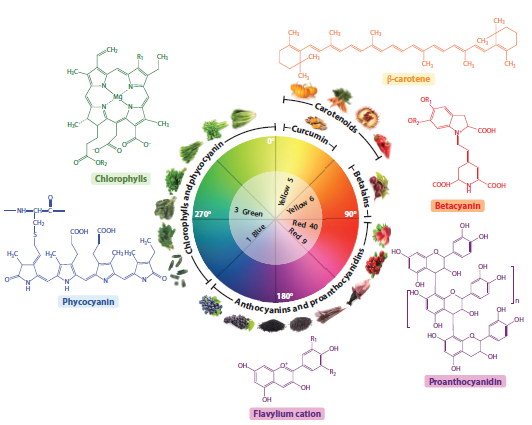
Figure 1. Colour and chemical structure compare four typical natural pigments: anthocyanins, betalains, carotenoids, and phycocyanins.
Table 1: Plant Natural Color
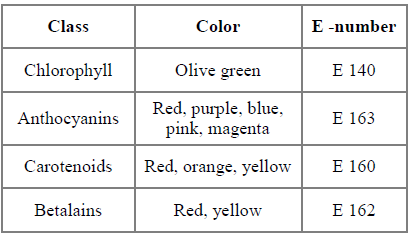
2.1 Betalains
Betalains are nitrogen-containing, water-soluble plant pigments found in most Caryophyllales plants. Betalains may be found in various plant components, including flowers, leaves, stems, and bracts. Violet betacyanins and yellow betaxanthins are the two types of betaxanthins. The pH range 5–6 is ideal for optimum betalain stability. When betanin solutions are stored in a low-oxygen environment, pigment degradation is minimized when stored in an air environment. Because the effects of light exposure are minimal in anaerobic settings, betalain light-driven degradation is oxygen dependant. Temperature is the most critical element influencing betalain stability during food preparation and storage. Table 2 shows some examples of plants that contain betalains.
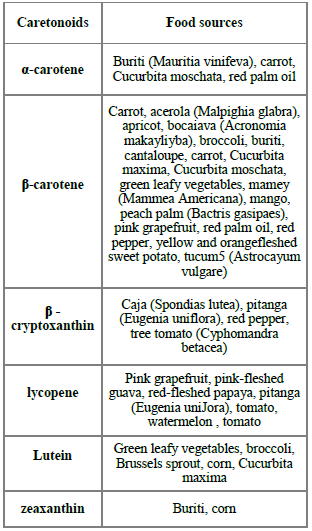
Table 2: Plants containing Betalains
2.2 Chlorophyll
Chlorophylls are oil-soluble pigments that are responsible for plants’ distinctive green hue. Porphyrins or tetrapyroles chelated with a central magnesium atom make up the structure of chlorophylls. Heat, light, oxygen, acids, and enzymes are all very sensitive to chlorophyll, causing rapid breakdown and colour change. They thrive in alkaline pH ranges of 7-9. In an acidic pH, it becomes unstable. When a plant’s cell membrane is exposed to light or heat, it degenerates, producing acids that lower the pH.
The primary cause of the chlorophyll colour change from green to olive-brown is acids and Mg-dechelatase, an enzyme present in algae and plants. These alterations are caused by the loss of a central magnesium atom in the chlorophyll structure, replaced by hydrogen ions, resulting in the transition of native chlorophylls into pheophytin, an olive-brown kind. Other enzymes that degrade chlorophyll and induce colour change include chlorophyllase and oxidative enzymes, including lipoxygenase, chlorophyll oxidase, and peroxidase. The plant-based beverage market requires this pigment to provide Colour and nutrition to many types of drinks.
2.3 Carotenoids
Plant pigments having 40 carbon atoms are known as carotenoids. Carotenoids are yellow-orange-red pigments present in all higher plants. Carotenoids are divided into two types: carotenes, which contain only carbon and hydrogen, and xanthophylls, which include carbon, hydrogen, and oxygen. Because carotenoids may be converted into retinol in the body, they contain provitamin A action. It is more stable between the pH ranges of 4.0 and 6.0. Carotenoids are degraded mostly by oxidation and isomerization events, which result in a reduction in the redness and yellowness of plant pigments.

Table 3: Plant sources of carotenoids
2.4 Anthocyanins
Anthocyanins are water-soluble plant pigments. Many fruits and vegetables have blue, purple, red, and orange colours because of them. The quantity and location of hydroxyl and methoxy groups on the basic anthocyanidin skeleton determine the variety of anthocyanins. If hydroxyl groups predominate, the Colour will take on a bluish hue; if methoxyl groups predominate, the Colour will become redder. Anthocyanin colour stability is influenced by various factors, including pH, temperature, light, co-pigments, enzymes, oxygen, and sugars. The crimson flavylium cation is the single predominating equilibrium species in high acidity environments. As the flavylium cation is hydrated to the colourless carbinol form by nucleophilic attack of water, increasing the pH reduces the flavylium cation’s colour intensity and concentration. When the pH rises even higher, the carbinol form gives way to the colourless chalcone via ring-opening. Food and beverage development use Anthocyanins to a considerable extent due to its neutral chemical composition and excellent Colour it provides to the food.
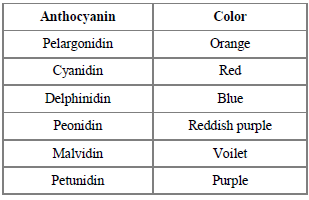
Table 4: Colors linked with common anthocyanins
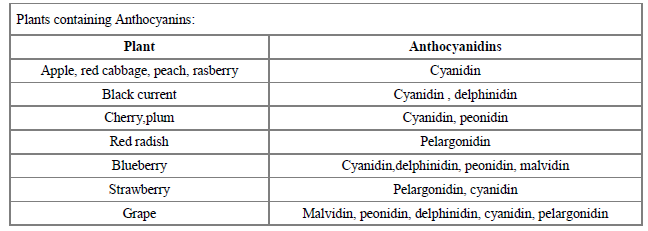
Table 5: Common sources of anthocyanins
Colour Appearance
It’s vital to remember that a single colouring agent may not provide the intended result; the background colour and nearby coloured substances significantly impact the colour appearance. Product designs that need blue or green limit the colour palette to just approved colours. Carmine can produce a bluish-purple, but it cannot make a pure blue.
Compared to the brilliant hue created by the FD&C-yellow, annatto or turmeric has a cheese hue or an eggy tone. Nowadays, fluorescent colours are also essential in the food industry as consumers favour foods to glow under conditions. Turmeric is a very fluorescent spice that is often used in cooking. The physical and chemical qualities of a food product usually limit the colourant options. A list of available shades for food-grade bio-colourant is presented in Table 6.
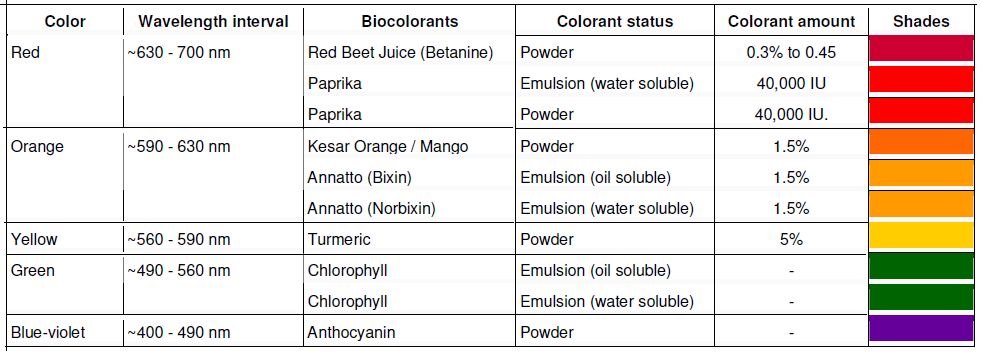
Table 6. A wide range of food-grade biocolorants
Advantages of Natural Dervied Food Colors
1. Health and Safety Benefits
The most important advantage of natural food colors is their safety for human consumption. Synthetic dyes such as Red 40, Yellow 5, and Blue 1 have been linked to health concerns ranging from allergic reactions to behavioral issues in children. In contrast, natural colorants come from edible, familiar sources like beets, turmeric, spinach, and gardenia fruit.
Key Benefits:
Non-toxic and non-carcinogenic
Free from petroleum derivatives
No known links to hyperactivity or behavioral problems
Generally Recognized As Safe (GRAS) by the FDA and approved by EFSA
These characteristics make natural food colors an ideal choice for baby foods, children’s snacks, dietary supplements, and other sensitive applications.

2. Supports Clean-Label and Transparency Trends
Today’s consumers want more than just great-tasting food—they want simple, transparent ingredient lists. Natural food colors help manufacturers create clean-label products that appeal to health-conscious shoppers.
Clean-Label Advantages:
Colors can be labeled as "colored with vegetable juice" or "colored with fruit extract"
Suitable for products marketed as organic, non-GMO, and minimally processed
Avoids artificial additives and allergens
Enhances consumer trust and brand loyalty
In short, natural food colors align perfectly with modern consumers' expectations for purity and honesty in food production.

3. Nutritional and Functional Properties
Natural pigments are not just colorants—they are often bioactive compounds with real health benefits. Many plant-based colorants contain antioxidants, vitamins, and anti-inflammatory compounds that support overall wellness.
Examples:
Curcumin (from turmeric): Anti-inflammatory, antioxidant, supports immune health
Anthocyanins (from red cabbage or berries): Improve blood flow, protect against heart disease
Chlorophyll (from leafy greens): Detoxifying, liver-supportive, antioxidant-rich
Betalains (from beetroot): Support cardiovascular health and reduce oxidative stress
Incorporating these functional colorants can enhance a product’s nutritional value, adding both appeal and wellness benefits.

4. Sustainability and Eco-Friendliness
Natural food colors support a more sustainable and environmentally responsible food system. While synthetic dyes are often petroleum-based and energy-intensive to manufacture, natural pigments are renewable, biodegradable, and minimally processed.
Sustainability Highlights:
Derived from renewable plant resources
Biodegradable and eco-friendly extraction processes
Lower carbon footprint compared to synthetic alternatives
Often produced with less water and energy
Consumers are increasingly aligning their purchasing behavior with environmental values. Choosing natural food colors is one way brands can showcase their commitment to planet-friendly practices.

5. Compatibility with Special Diets
As dietary diversity expands globally, manufacturers must cater to a wide range of dietary needs. Natural food colors are an excellent fit for products that are:
Vegan and Vegetarian
Halal and Kosher Certified
Gluten-Free and Allergen-Free
Organic and Non-GMO
At Yangge Biotech, we ensure our natural colorants meet rigorous dietary and regulatory standards, making them suitable for a wide range of global markets and niche consumer segments.

6. Rich Variety of Color Tones and Shades
Thanks to advances in natural pigment extraction and formulation, it is now possible to achieve a vibrant, stable spectrum of color shades using only plant-based ingredients.
Examples from Yangge Biotech:
Natural Yellow: Extracted from turmeric, gardenia, and safflower—used in snacks, sauces, and dairy
Natural Red: From beetroot and red cabbage—ideal for confections, yogurts, and meat substitutes
Natural Green: From spinach, chlorophyllin, and matcha—popular in beverages, pasta, soups, and functional products.

7. Explore Naturally Derived Food Colors from Yangge Biotech
At Yangge Biotech, our natural colorants are carefully extracted from plants, fruits, and vegetables using advanced techniques that preserve both color integrity and nutritional content. Our commitment to naturally derived food colors ensures that you receive:
High purity and vivid visual appeal
Long shelf-life and formulation stability
Regulatory compliance with major global food standards
We invite formulators, food technologists, and ingredient buyers to explore our wholesale colorant options, whether you're developing beverages, snacks, confectionery, or nutritional products. From sample support to custom color-matching, our team is here to assist every step of the way.
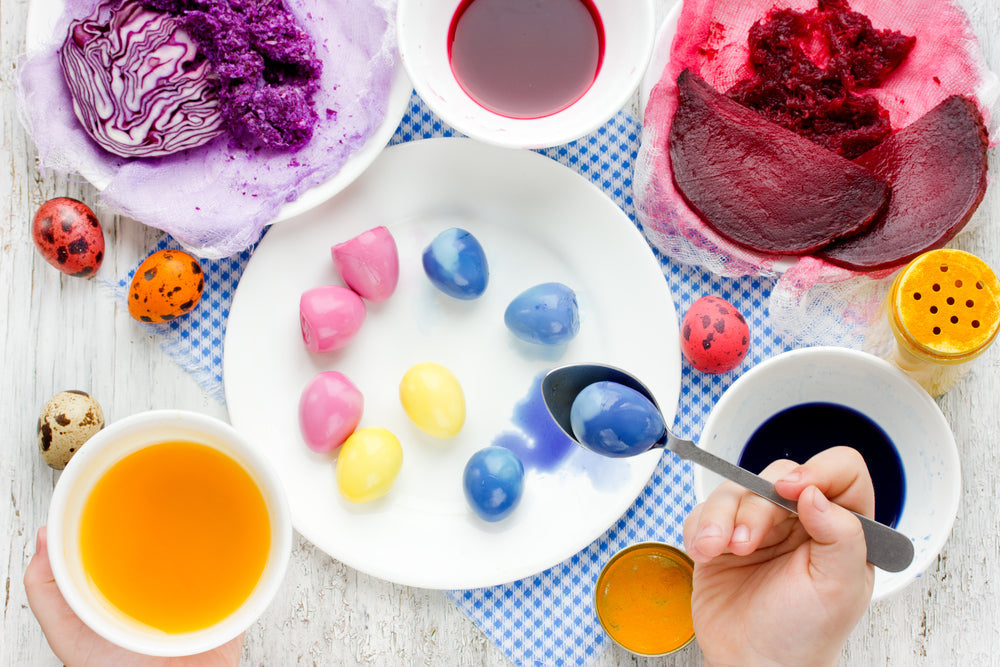
Conclusion
Switching to natural food colors is not just a consumer-driven trend—it's a responsible, health-forward business decision. With benefits ranging from safety and nutrition to sustainability and clean-label marketing, these colors are setting the standard for innovation in every food category.
At Yangge Biotech, we are committed to helping your brand stay ahead of the curve with premium-quality, naturally derived food colors that are safe, vibrant, and aligned with global health trends. Explore our full catalog of plant-based and fruit-derived food colorants today. Bulk Supply Available Contact Us: info@yanggebiotech.com
Send Inquiry
Related Industry Knowledge
- Boost Your Energy with Glutathione: Here’s How
- Exploring Blue Spirulina E10: Trends and Benefits
- Beetroot Red: Your Guide to Vibrant Health
- Exploring Chlorophyll: The Green Miracle for Weight Loss
- Feel Good with Organic Powder Turmeric
- Can I take chlorophyll at night?
- Should i take 5-htp in the morning or at night?
- β-Carotene 1% CWS: A Natural Solution for Vibrant Colors and Optimal Health
- Is it safe to drink butterfly pea flower everyday?
- Does CLA (conjugated linoleic acid) work for belly fat?


